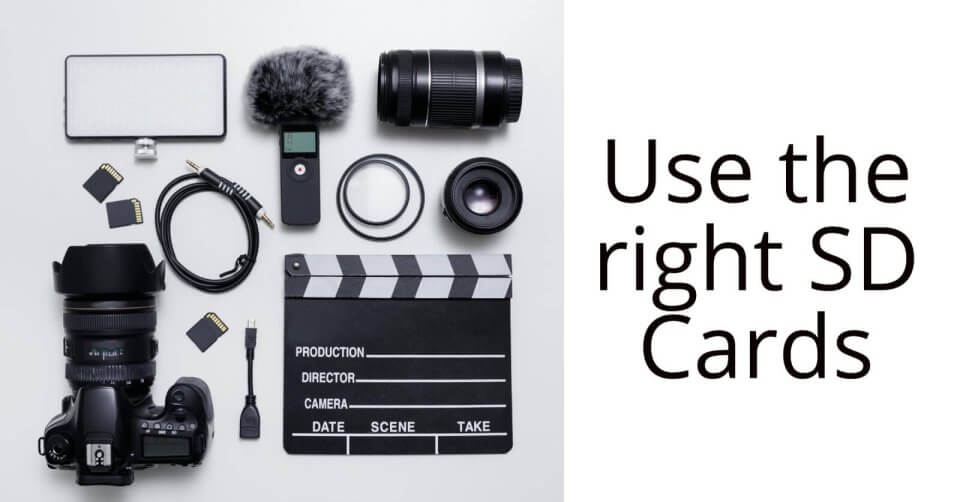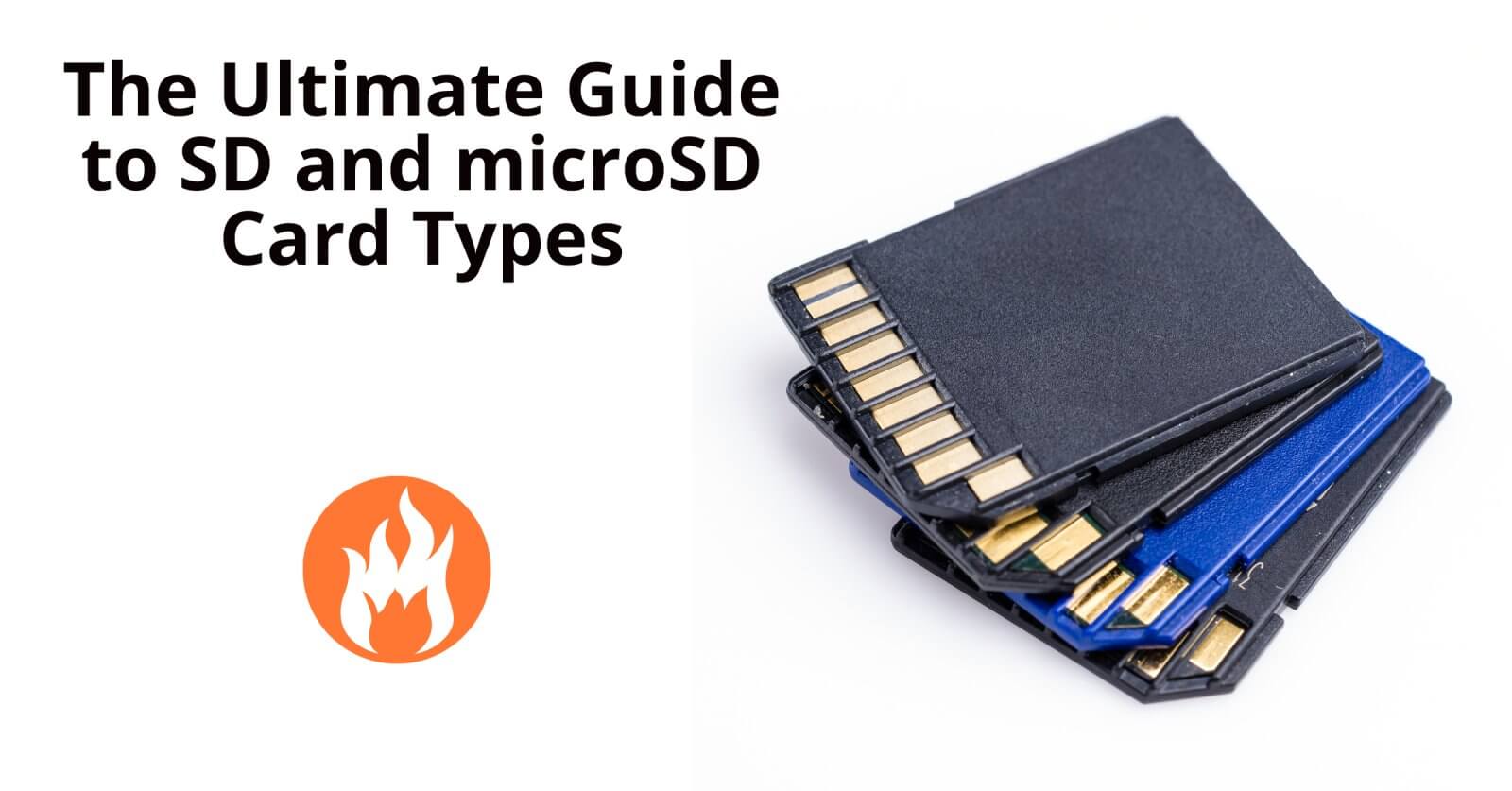Guide to SD and microSD Card Types
The most commonly used memory cards in smartphones, digital cameras, and other devices that need more storage space are SD (Secure Digital) and microSD cards. It is important to choose the right card type for your specific device, as this can affect performance and compatibility.
There are several types of SD cards, including SD, SDHC, SDXC, and SDUC. SD cards have a maximum capacity of 2GB, while SDHC cards can store up to 32GB. SDXC cards offer even greater storage capacity, with a maximum of 2TB. SDUC cards, the latest addition to the SD card family, can potentially reach up to 128TB of storage.
Similarly, microSD cards come in different variants, including microSD, microSDHC, microSDXC, and microSDUC. They follow the same capacity specifications as their full-sized counterparts, with microSD cards having a maximum capacity of 2GB, microSDHC cards offering up to 32GB, microSDXC cards providing storage of up to 2TB, and microSDUC cards potentially supporting up to 128TB.
When selecting a card type, it’s crucial to consider the storage capacity required by your device and its compatibility with different SD and microSD card formats. For example, some digital cameras may only support SDHC or SDXC cards, while certain smartphones may be compatible with microSDXC cards.
By understanding the different SD and microSD card types, you can make an informed decision and ensure optimal performance for your devices’ storage needs.
Types of SD Cards
There are different types of SD cards available based on their sizes, speed, and compatibility with devices.
SD memory cards are the standard size cards used in devices like digital cameras and card readers. They offer various capacities ranging from 2GB to 2TB.
MicroSD cards are smaller versions of SD cards and are commonly used in smartphones and tablets. They come in different sizes like microSD, microSDHC, microSDXC, and microSDUC, with capacities up to 128TB.
Compact flash memory cards are larger in size and are used primarily in professional cameras and video recorders. They offer high-speed data transfer rates and can store up to several terabytes of data.
The speed of SD cards is categorized using classes or UHS rating, indicating their read and write speeds. Classes range from Class 2 to Class 10, while UHS ratings include UHS-I and UHS-II. Higher speed classes are recommended for tasks like HD video recording and faster data transfer.
When choosing an SD card, consider the compatibility with your device’s card slot and the storage capacity required. Ensure the card’s speed meets the requirements for optimal performance.

Types of microSD Cards
MicroSD cards are smaller, more compact versions of SD memory cards that are commonly used to expand the storage capacity of smartphones, drones, gaming devices, and cameras. Despite their small size, microSD cards offer various specifications and capacities.
There are four SD standards for microSD cards, each based on their capacity. The microSD standard supports capacities up to 2GB, while the microSDHC (High Capacity) standard can hold between 2GB and 32GB of data. For larger storage needs, the microSDXC (eXtended Capacity) standard can accommodate between 32GB and 2TB of data. The newest addition is the microSDUC (Ultra Capacity) standard, which has a potential capacity of up to 128TB.
One of the advantages of microSD cards is their backward-compatibility feature. This means that they can be used in hardware devices designed for older standard microSD cards. For example, a microSDXC card can be used in a device that was initially compatible with the microSDHC standard. This allows users to easily upgrade their storage capacity without having to replace their devices.
In conclusion, microSD cards are essential accessories for expanding the storage capacity of various devices. With different specifications and capacities, they offer a versatile solution for users who need more space to store their photos, videos, and files.
SD: What Does It Mean?
SD stands for “Secure Digital” and is a memory card format that is widely used in various electronic devices. The significance of SD lies in its versatility and compatibility with a wide range of devices, including digital cameras, mobile phones, video recorders, and more.
There are different tiers of SD cards based on their memory capacity. The Standard SD cards have a maximum capacity of 2GB. These cards are suitable for older devices and have been widely used in the past.
The SDHC (High Capacity) cards, on the other hand, can hold between 2GB and 32GB of data. These cards offer increased storage capacity and are commonly used in modern devices that require more space for photos, videos, and other files.
For even larger storage needs, the SDXC (Extended Capacity) cards are available. These cards can accommodate between 32GB and 2TB of data, making them ideal for high-resolution photos, HD videos, and other data-intensive applications.
In summary, SD is a memory card format that offers different tiers of cards based on memory capacity. From the Standard SD cards with a maximum capacity of 2GB to the SDHC cards with capacities up to 32GB, and the SDXC cards with capacities up to 2TB, there is an SD card to suit various storage requirements.
SD Card Labeling and Specifications
SD Card Labeling and Specifications:
When it comes to SD cards, it’s important to understand the labeling and specifications to ensure the right fit for your device. SD cards are labeled based on their capacity and speed class. The capacity refers to the amount of data the card can hold, while the speed class indicates the minimum write speed for video recording.
In terms of capacity, there are three main types: Standard SD cards, SDHC cards, and SDXC cards. Standard SD cards have a maximum capacity of 2GB and are suitable for older devices. SDHC cards, on the other hand, can hold between 2GB and 32GB of data, making them ideal for modern devices. For even larger storage needs, SDXC cards can accommodate between 32GB and 2TB of data, perfect for high-resolution photos and HD videos.
In addition to capacity, speed class is important for video recording. The speed class is indicated by a number inside a circle, ranging from 2 to 10. The higher the number, the faster the minimum write speed. For example, speed class 10 ensures a minimum write speed of 10MB per second, which is ideal for recording high-quality Full HD videos.
Understanding SD card labeling and specifications allows you to choose the right card for your device, ensuring optimal storage and performance.
| SD Card Type | Capacity | Speed Rating | Good For |
|---|---|---|---|
| SD | Up to 2 GB | Class 2, 4, 6, 10 | Basic storage for digital cameras, music players, and other devices |
| SDHC | 4 GB to 32 GB | Class 2, 4, 6, 10, UHS-I | Higher-resolution photos and videos, burst mode shooting, and continuous recording |
| SDXC | 32 GB to 2 TB | UHS-I, UHS-II, UHS-III, SD Express | 4K and 8K video recording, high-speed data transfer, and professional photography |
| SDUC | 2 TB to 128 TB | UHS-I, UHS-II, UHS-III, SD Express | Ultra-high-resolution video recording and professional photography |

Differences
The main differences between SD card types are their capacity and speed rating. Capacity refers to how much data the card can store, while speed rating refers to how fast the card can read and write data.
SDHC cards offer a significant increase in capacity over SD cards, making them ideal for storing high-resolution photos and videos. SDXC cards offer even more capacity, and they are also faster than SDHC cards, making them ideal for 4K and 8K video recording. SDUC cards are the newest type of SD card, and they offer the highest capacity and speed of any SD card.
Speed Rating
SD card speed ratings are indicated by different symbols, such as Class 2, Class 4, Class 6, Class 10, UHS-I, UHS-II, UHS-III, and SD Express. The higher the speed rating, the faster the card can read and write data.
Class 2, 4, 6, and 10 cards are the slowest type of SD card. They are suitable for basic storage needs, such as storing photos and music. UHS-I cards are faster than Class 2, 4, 6, and 10 cards, and they are ideal for storing and transferring high-resolution photos and videos. UHS-II and UHS-III cards are even faster than UHS-I cards, and they are ideal for 4K and 8K video recording. SD Express cards are the fastest type of SD card, and they are ideal for professional photography and videography.
What They Are Good For
The type of SD card you need depends on your needs. If you are just looking for a basic SD card to store photos and music, a Class 2, 4, 6, or 10 card will suffice. If you are shooting high-resolution photos and videos, you will need an SDHC or SDXC card with a speed rating of UHS-I or higher. If you are shooting 4K or 8K video, you will need an SDXC or SDUC card with a speed rating of UHS-II, UHS-III, or SD Express.
Here are some specific examples of what different types of SD cards are good for:
- SD cards: Basic storage for digital cameras, music players, and other devices
- SDHC cards: Higher-resolution photos and videos, burst mode shooting, and continuous recording
- SDXC cards: 4K and 8K video recording, high-speed data transfer, and professional photography
- SDUC cards: Ultra-high-resolution video recording and professional photography
UHS Speed Class
The UHS Speed Class is a specification that determines the minimum write speed for microSD cards that support the UHS-I, II, and III bus speeds. It is an important factor to consider when choosing a memory card for devices that require high-speed data transfer, such as digital cameras and action cameras.
UHS-I and UHS-II microSD cards have two possible grades within the UHS Speed Class. The U1 grade guarantees a minimum write speed of 10 MB/s, while the U3 grade ensures a minimum write speed of 30 MB/s. This makes U3 microSD cards ideal for recording 4K video and capturing high-resolution photos without any lag or dropped frames.
It’s worth noting that UHS memory cards are designed to work best with UHS host devices. When used together, they can achieve optimal performance and deliver smooth HD resolution videos and real-time broadcasts. However, UHS memory cards are also compatible with non-UHS devices, but they will operate at lower speeds.
When shopping for a microSD card, be sure to check the UHS Speed Class to ensure that it meets the requirements of your device and intended use. Whether you’re shooting professional-grade videos or simply need fast and reliable storage for your mobile devices, UHS-I and UHS-II microSD cards offer the speed and performance you need.
UHS-I vs. UHS-II vs. UHS-III vs. SD Express
UHS-I, UHS-II, UHS-III, and SD Express are different types of SD cards that vary in terms of bus interface technology, maximum bus speeds, and device compatibility.
UHS-I SD cards use a single row of pins and have a maximum bus speed of 104 MB/s. They are widely compatible with most SD card devices on the market, making them a popular choice for digital cameras, mobile phones, and card readers.
UHS-II SD cards, on the other hand, feature a dual-row pin design and support higher bus speeds of up to 312 MB/s. However, to achieve these higher speeds, both the UHS-II card and the device it’s used with must support the UHS-II interface. UHS-II cards are used in professional digital cameras and high-performance video recorders.
UHS-III SD cards further enhance the bus speeds, with a maximum potential speed of 624 MB/s. Similar to UHS-II, UHS-III cards require both the card and the device to support the UHS-III interface to obtain these faster transfer rates. UHS-III cards are primarily used in high-end cinematic cameras and other professional-grade recording devices.
SD Express is a newer SD card technology that combines the traditional SD interface with a PCIe (Peripheral Component Interconnect Express) interface. This enables even faster transfer speeds, reaching up to 985 MB/s. However, SD Express cards are only compatible with devices that support the SD Express interface.
In conclusion, the speed and performance of UHS-I, UHS-II, UHS-III, and SD Express SD cards vary based on the bus interface technology, maximum bus speeds, and device compatibility. Users should ensure their devices support the appropriate interface to maximize the potential speeds offered by these SD card types.
Video Speed Class
Video Speed Class is a classification system designed to indicate the minimum sequential write speed of an SD card for video recording. It plays a crucial role in ensuring smooth and uninterrupted video capture, especially for high-resolution and high-bitrate recordings.
The Video Speed Class ranges from V6 to V90, with each class representing a specific minimum write speed. V6 has a minimum write speed of 6MBps, while V10 has a minimum write speed of 10MBps. As we move up the classes, the minimum speeds increase: V30 has 30MBps, V60 has 60MBps, and V90 has 90MBps.
These classes help users choose the appropriate SD card for their specific video recording needs. For example, a V6 card may be suitable for standard definition recordings, while a V90 card would be ideal for professional-grade 8K video recording.
It is essential to note that using an SD card with a lower Video Speed Class than recommended for your recording settings may result in dropped frames, buffering issues, or even data loss. Therefore, it is crucial to select an SD card with a Video Speed Class that meets the requirements of your recording device and desired video quality.
The Capacity Of SD Card
SD cards have come a long way in terms of storage capacity to meet the ever-increasing demands of modern devices. Initially, smaller capacity SD cards with 1-2GB were common. However, with the rise of technologies like HD video recording, higher storage capacities have become essential.
Nowadays, it is common to find SD cards with massive storage capacities of up to 128GB. These cards are capable of storing large amounts of data, including high-resolution photos, hours of HD video, and extensive music libraries. The shift to such larger capacities has been driven by the need for more storage space to accommodate the growing file sizes and content of modern devices.
Determining the appropriate capacity for different devices and usage scenarios depends on factors such as the type of device, intended use, and personal preferences. For example, if you frequently record HD videos or capture RAW images on your digital camera, a higher capacity SD card like 64GB or 128GB would be suitable to avoid running out of space during important moments.
On the other hand, if you primarily use your SD card for storing documents, music, or small video clips on your mobile phone or a lower-spec camera, a smaller capacity like 16GB or 32GB may suffice.
In conclusion, the capacity of SD cards has significantly evolved to accommodate the storage needs of modern devices and their associated high-resolution content. Selecting the appropriate capacity entails considering the type of device and usage requirements to ensure sufficient storage space for seamless functionality.
Best SD Card Types for Dashcams & Surveillance Cameras
When it comes to choosing the best SD card for dashcams and surveillance cameras, durability and performance are key factors to consider. For continuous use and added protection against failure, endurance SD cards are highly recommended. Brands such as Samsung and SanDisk offer specifically designed endurance SD cards that are built to withstand constant writing and rewriting of footage.
In addition to durability, storage capacity and sequential write speeds play a crucial role in action cameras. It is important to have ample storage space to accommodate long recording hours. Furthermore, fast sequential write speeds are essential for capturing high-definition footage without any lag or dropped frames. Look for SD cards with V30, V60, or V90 ratings, as these indicate superior write speeds and can handle the demands of recording action-packed scenes.
By choosing the right SD card, reliable and uninterrupted recording is assured, ensuring that important footage is captured accurately. Whether it is for dashcams, surveillance cameras, or action cameras, endurance SD cards with high storage capacity and fast sequential write speeds are crucial to ensure optimal performance.
Best Types of SD Card for Gaming Devices
When it comes to gaming devices like the Nintendo Switch, having the right SD card is essential for a smooth gaming experience. These devices require cards with fast write speeds and the ability to handle small data chunks efficiently. While some SD cards may not have a specific rating for gaming, it’s best to look for cards with an “A” rating, such as A1 or A2. These cards are designed to handle the demands of gaming devices.
To ensure optimal gaming performance, it’s important to choose an SD card with fast write speeds. This allows for quick loading times and seamless gameplay. Additionally, gaming devices often utilize smaller data chunks, so it’s crucial to choose a card that can handle this type of data efficiently.
When selecting an SD card for your gaming device, consider these top 5 keywords: gaming devices, Nintendo Switch, A rating, fast write speeds, and small data chunks. By focusing on these factors, you can ensure that you choose the best SD card to enhance your gaming experience.
Best Types of SD Card for Action Cameras
When it comes to action cameras, choosing the right SD card is crucial for capturing high-quality footage. These cameras often record high-bitrate and high-resolution video, which requires a card with fast sequential write speeds. For this reason, cards with V30, V60, or V90 ratings are highly recommended.
Action cameras typically use microSD cards, so it’s important to choose a card with a fast sequential write speed to handle the continuous data recording required during intense action shots. A fast write speed ensures smooth and uninterrupted video recording.
The V30, V60, and V90 ratings indicate the minimum sequential write speeds of 30MB/s, 60MB/s, and 90MB/s respectively. These ratings guarantee that the SD card can handle the high data transfer required for recording action-packed videos without dropping frames or causing buffering issues.
To ensure the best performance, it’s recommended to invest in a high-quality SD card with a fast sequential write speed. This will not only enhance video recording but also minimize the risk of losing valuable footage during action-packed moments. So, make sure to choose the right SD card for your action camera and capture every thrilling moment seamlessly.
Best Types of SD Cards for Storing & Archiving Data
When it comes to storing and archiving data, SD cards are a popular choice due to their compact size and compatibility with various devices. While they are not typically recommended for long-term data storage, they serve as great backup solutions or for creating portable collections.
There are different types of SD cards available, each with its own compatibility features. Standard SD cards are widely used in digital cameras and offer storage capacities ranging from a few gigabytes to several terabytes. microSD cards, on the other hand, are commonly used in mobile phones and other portable devices.
When choosing an SD card, the sequential write speed rating is crucial, especially for cameras. This rating ensures smooth and uninterrupted video recording, making it ideal for action shots. Higher ratings, such as V30, V60, and V90, guarantee minimum sequential write speeds of 30MB/s, 60MB/s, and 90MB/s respectively, enabling flawless data transfer without buffering issues.
While SD cards may not be the go-to solution for long-term storage, they offer convenience and versatility for backing up important data or creating portable collections. Remember to choose the right type and consider the sequential write speed rating to ensure optimal performance.
FAQs people ask about SD cards:
- What is an SD card? An SD card is a removable memory card that can be used to store data in a variety of devices, such as digital cameras, smartphones, and tablets. SD cards are relatively small and lightweight, making them easy to carry with you.
- What are the different types of SD cards? There are four main types of SD cards: SD, SDHC, SDXC, and SDUC. SD cards have a capacity of up to 2 GB, SDHC cards have a capacity of 4 GB to 32 GB, SDXC cards have a capacity of 32 GB to 2 TB, and SDUC cards have a capacity of 2 TB to 128 TB.
- Which type of SD card do I need? The type of SD card you need depends on your device and your storage needs. If you have a digital camera that shoots high-resolution photos and videos, you will need an SDHC or SDXC card with a speed rating of UHS-I or higher. If you are shooting 4K or 8K video, you will need an SDXC or SDUC card with a speed rating of UHS-II, UHS-III, or SD Express.
- How do I format an SD card? To format an SD card, you can use your device’s settings or a card reader connected to your computer. Formatting an SD card will erase all of the data on the card, so be sure to back up any important files before you format the card.
- How can I protect my SD card from data loss? There are a few things you can do to protect your SD card from data loss:
- Back up your data regularly.
- Avoid using the card in extreme temperatures.
- Do not eject the card while your device is still accessing it.
- Use a virus scanner to scan your card for malware.
How long do SD Cards last?
SD cards typically last for 10 years or more, but their actual lifespan depends on a number of factors, including:
- Quality: Higher-quality SD cards are more likely to last longer than lower-quality cards.
- Usage: SD cards that are used frequently are more likely to wear out sooner than SD cards that are used less often.
- Environmental conditions: SD cards that are exposed to extreme temperatures or humidity are more likely to fail sooner than SD cards that are kept in a cool, dry environment.
It’s important to regularly back up your data, especially if you store important files on an SD card.
Here are some tips for extending the lifespan of your SD card:
- Avoid using the card in extreme temperatures.
- Do not eject the card while your device is still accessing it.
- Use a virus scanner to scan your card for malware.
- Format your card regularly, but only if necessary.
- Store your card in a cool, dry place when you are not using it.
Conclusion
In conclusion, the world of SD and microSD cards is a dynamic and ever-evolving landscape that plays a crucial role in our increasingly digital lives. Whether you’re a photographer seeking high-speed performance, a smartphone user looking for expanded storage, or a gamer needing fast access to game data, understanding the various types and specifications of SD and microSD cards is essential.
In this comprehensive guide, we’ve explored the different SD and microSD card types, their physical sizes, and the various capacity options available. We’ve delved into the importance of speed classes, UHS ratings, and application performance classes, helping you make informed decisions when selecting the right card for your specific needs.
As technology continues to advance, we can anticipate even faster and more capacious SD and microSD cards to meet the demands of future devices and applications. Therefore, staying up-to-date with the latest developments and choosing the right card for your devices will remain a critical consideration.
Ultimately, whether you’re aiming for high-speed photography, smooth 4K video recording, or seamless app performance, the right SD or microSD card can make all the difference. Armed with the knowledge from this guide, you’re now well-equipped to select the perfect card to enhance your digital experiences and ensure that your data is safely stored and easily accessible. So, as you embark on your tech adventures, may your storage be ample, your speed be swift, and your memories be preserved for years to come.
























